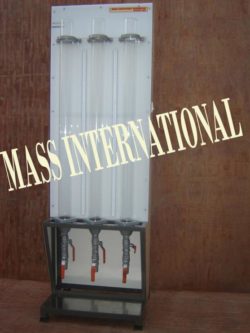FM 27 DRAG CO-EFFICIENT
DESCRIPTIONThe apparatus has been designed to introduce students to the fundamental characteristics of the behavior of the particle system, in particulars the relationship between the drag coefficient of falling particles and their Reynolds number value. Particles covering a range of sizes and densities are supplied and the experiments are conducted by allowing single particles to fall through a number of different liquids contained in vertical glass tube. The rate of fall of the particle is determined by timing their passage between two marks on the walls of the glass tubes. Observation of particle movement is aided by the provision of a shielded fluorescent tube light mounted on the backboard. Particles can be removed from the bottom of the tubes without the necessity of draining the liquid. A valve system is provided at the bottom of each tube to allow the particles to be removed with the minimum loss of liquid.
- • To measure the drag co-efficient
- • To plot the graph between drag co-efficient vs. Modified Reynolds number
- • To study the motion of a solid particle through a liquid

- • Electricity supply 100 watts, 220 , 1 phase
- • Floor Area 0.75 m x 1.5 m
- • Liquids of different viscosity
TECHNICAL SPECIFICATIONS
| Product & Code | Drag Coefficient & FM 27 |
|---|---|
| Tubes (2 nos.) | Material Borosilicate Glass tube, Dia 50 mm, Length 1200 mm (approx.) |
| Stop watch | Electronic type |
| Steel and glass balls of different sizes will be provided |
The whole setup is well designed and arranged in a good quality painted structure.
ABOUT OUR COMPANY
WE MANUFACTURERS WIDE RANGE OF PRODUCTS LIKE HEAT TRANSFER LAB EQUIPMENT, HYDRAULIC BENCH, HYDRAULIC MACHINES LAB EQUIPMENT, ETC. WE MANUFACTURE THESE PRODUCTS AS PER THE LATEST MARKET TRENDS AND DELIVER THESE AT USERS’ PREMISES WITHIN THE SCHEDULED TIME FRAME.
Contact Us
Have questions, comments or just want to say hello:
- mass_international99@yahoo.co.in
- 92156-00789 , 9215900789, 9812225689, 9812200689
- Regd. Office Works:
Plot No. 459, Sector – 2, Phase – 1, Industrial Estate Growth Centre,HSIIDC, Saha – 133104
GSTIN. No. 06ADYPK5042P1ZS
Website Design By | Design: Fame Digital Worlds by Fame Digital Worlds
